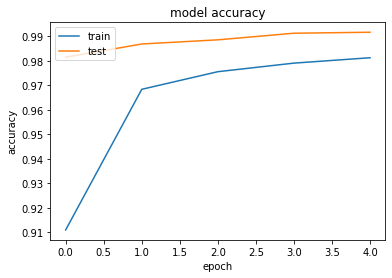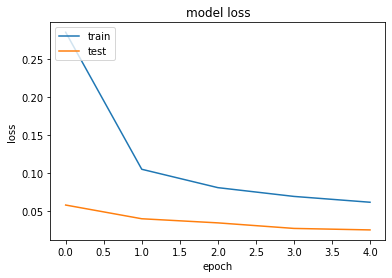Deep Learning Pipeline Tflite
import tensorflow as tf
import numpy as np
import matplotlib.pyplot as plt
keras = tf.keras
tf.__version__
'1.14.0'
1. Get Dataset
(x_train, y_train), (x_test, y_test) = keras.datasets.mnist.load_data()
print("x_train shape:", x_train.shape, "y_train shape:", y_train.shape)
print("x_test shape:", x_test.shape, "y_test shape:", y_test.shape)
x_train shape: (60000, 28, 28) y_train shape: (60000,)
x_test shape: (10000, 28, 28) y_test shape: (10000,)
plt.subplot(1, 4, 1)
plt.imshow(x_train[0]) # first train
plt.subplot(1, 4, 2)
plt.imshow(x_train[59999]) # last train
plt.subplot(1, 4, 3)
plt.imshow(x_test[0]) # first test
plt.subplot(1, 4, 4)
plt.imshow(x_test[9999]) # last test
<matplotlib.image.AxesImage at 0x2db881816d8>

2. Get Dataset
num_classes = 10
x_train = x_train.astype('float32')
x_test = x_test.astype('float32')
# Normalize the input data
x_train = x_train.astype('float32') / 255
x_test = x_test.astype('float32') / 255
# Reshape input data from (28, 28) to (28, 28, 1)
w, h = 28, 28
x_train = x_train.reshape(x_train.shape[0], w, h, 1)
x_test = x_test.reshape(x_test.shape[0], w, h, 1)
# One-hot encode the labels
y_train = keras.utils.to_categorical(y_train, num_classes)
y_test = keras.utils.to_categorical(y_test, num_classes)
print("x_train shape:", x_train.shape, "y_train shape:", y_train.shape)
print("x_test shape:", x_test.shape, "y_test shape:", y_test.shape)
x_train shape: (60000, 28, 28, 1) y_train shape: (60000, 10)
x_test shape: (10000, 28, 28, 1) y_test shape: (10000, 10)
3. Create model
def create_model():
model = keras.models.Sequential([
keras.layers.Conv2D(filters=32, kernel_size=3, padding='same', activation='relu', input_shape=(28,28,1)),
keras.layers.MaxPooling2D(pool_size=2),
keras.layers.Dropout(0.3),
keras.layers.Conv2D(filters=64, kernel_size=3, padding='same', activation='relu'),
keras.layers.MaxPooling2D(pool_size=2),
keras.layers.Dropout(0.3),
keras.layers.Flatten(),
keras.layers.Dense(128, activation='relu'),
keras.layers.Dropout(0.5),
keras.layers.Dense(10, activation='softmax')
])
model.compile(loss=keras.losses.categorical_crossentropy,
optimizer=keras.optimizers.Adam(),
metrics=['accuracy'])
return model
model = create_model()
model.summary()
WARNING: Logging before flag parsing goes to stderr.
W1008 19:20:59.557817 3592 deprecation.py:506] From C:\Program Files\Anaconda3\envs\latest\lib\site-packages\tensorflow\python\ops\init_ops.py:1251: calling VarianceScaling.__init__ (from tensorflow.python.ops.init_ops) with dtype is deprecated and will be removed in a future version.
Instructions for updating:
Call initializer instance with the dtype argument instead of passing it to the constructor
Model: "sequential"
_________________________________________________________________
Layer (type) Output Shape Param #
=================================================================
conv2d (Conv2D) (None, 28, 28, 32) 320
_________________________________________________________________
max_pooling2d (MaxPooling2D) (None, 14, 14, 32) 0
_________________________________________________________________
dropout (Dropout) (None, 14, 14, 32) 0
_________________________________________________________________
conv2d_1 (Conv2D) (None, 14, 14, 64) 18496
_________________________________________________________________
max_pooling2d_1 (MaxPooling2 (None, 7, 7, 64) 0
_________________________________________________________________
dropout_1 (Dropout) (None, 7, 7, 64) 0
_________________________________________________________________
flatten (Flatten) (None, 3136) 0
_________________________________________________________________
dense (Dense) (None, 128) 401536
_________________________________________________________________
dropout_2 (Dropout) (None, 128) 0
_________________________________________________________________
dense_1 (Dense) (None, 10) 1290
=================================================================
Total params: 421,642
Trainable params: 421,642
Non-trainable params: 0
_________________________________________________________________
4. Train Model
%%time
history = model.fit(
x_train,
y_train,
batch_size=64,
epochs=5,
validation_data=(x_test, y_test))
Train on 60000 samples, validate on 10000 samples
Epoch 1/5
60000/60000 [==============================] - 32s 540us/sample - loss: 0.2854 - acc: 0.9109 - val_loss: 0.0581 - val_acc: 0.9815
Epoch 2/5
60000/60000 [==============================] - 32s 537us/sample - loss: 0.1052 - acc: 0.9684 - val_loss: 0.0401 - val_acc: 0.9869
Epoch 3/5
60000/60000 [==============================] - 32s 536us/sample - loss: 0.0810 - acc: 0.9756 - val_loss: 0.0347 - val_acc: 0.9886
Epoch 4/5
60000/60000 [==============================] - 33s 542us/sample - loss: 0.0695 - acc: 0.9791 - val_loss: 0.0274 - val_acc: 0.9913
Epoch 5/5
60000/60000 [==============================] - 32s 533us/sample - loss: 0.0618 - acc: 0.9813 - val_loss: 0.0254 - val_acc: 0.9917
Wall time: 2min 41s
5. Evaluate Model
score = model.evaluate(x_test, y_test, verbose=1)
print("\nTest score:", score[0])
print('Test accuracy:', score[1])
10000/10000 [==============================] - 1s 141us/sample - loss: 0.0254 - acc: 0.9917
Test score: 0.025416590155386803
Test accuracy: 0.9917
print(history.history.keys())
plt.plot(history.history['acc'])
plt.plot(history.history['val_acc'])
plt.title('model accuracy')
plt.ylabel('accuracy')
plt.xlabel('epoch')
plt.legend(['train', 'test'], loc='upper left')
plt.show()
dict_keys(['loss', 'acc', 'val_loss', 'val_acc'])

plt.plot(history.history['loss'])
plt.plot(history.history['val_loss'])
plt.title('model loss')
plt.ylabel('loss')
plt.xlabel('epoch')
plt.legend(['train', 'test'], loc='upper left')
plt.show()

6. Save Model
keras_model = "keras_model.h5"
keras.models.save_model(model, keras_model)
7. Convert Keras model to TFLite model for Android
from datetime import date
converter = tf.lite.TFLiteConverter.from_keras_model_file(keras_model)
tflite_model = converter.convert()
tflite_model_file_name = "mnist_" + tf.__version__ + "_" + str(date.today()) + ".tflite"
open(tflite_model_file_name, "wb").write(tflite_model)
W1008 19:32:14.385704 3592 deprecation.py:506] From C:\Program Files\Anaconda3\envs\latest\lib\site-packages\tensorflow\python\ops\init_ops.py:97: calling GlorotUniform.__init__ (from tensorflow.python.ops.init_ops) with dtype is deprecated and will be removed in a future version.
Instructions for updating:
Call initializer instance with the dtype argument instead of passing it to the constructor
W1008 19:32:14.387699 3592 deprecation.py:506] From C:\Program Files\Anaconda3\envs\latest\lib\site-packages\tensorflow\python\ops\init_ops.py:97: calling Zeros.__init__ (from tensorflow.python.ops.init_ops) with dtype is deprecated and will be removed in a future version.
Instructions for updating:
Call initializer instance with the dtype argument instead of passing it to the constructor
W1008 19:32:14.908329 3592 deprecation.py:323] From C:\Program Files\Anaconda3\envs\latest\lib\site-packages\tensorflow\lite\python\util.py:238: convert_variables_to_constants (from tensorflow.python.framework.graph_util_impl) is deprecated and will be removed in a future version.
Instructions for updating:
Use `tf.compat.v1.graph_util.convert_variables_to_constants`
W1008 19:32:14.909357 3592 deprecation.py:323] From C:\Program Files\Anaconda3\envs\latest\lib\site-packages\tensorflow\python\framework\graph_util_impl.py:270: extract_sub_graph (from tensorflow.python.framework.graph_util_impl) is deprecated and will be removed in a future version.
Instructions for updating:
Use `tf.compat.v1.graph_util.extract_sub_graph`
1688684
-mkc
Written on October 8, 2019